Growing Carrots from Seed to Harvest
March 23rd, 2021 | Categories
What’s up doc? The UK seems to love carrots just as much as Bugs Bunny. Each year Britain plants more than 22 billion carrot seeds, and it is thought that the average person will consume more than 100 whole carrots each per year. That is a lot of carrots! We use carrots in so many of our dishes from soups to salads, to our perennial British favourites like Shepherd and Cottage Pie, and let’s not forget what a treat carrot cake is. Yum yum! They’re also a typically easy vegetable to grow for beginners and seasoned gardeners, so it is no wonder the versatile carrot is an immensely popular vegetable for allotment and home growers.
Growing carrots from seed to harvest at home is a straightforward process – even for beginners – that will reward you with a crop of fresh, deliciously flavoursome, crisp carrots to enjoy. There are many different varieties of carrot from big to small, carrots that are red, purple or yellow, with different flavour profiles too. Whatever variety you wish to grow this guide will give you the information on what to do from seed all the way to harvest. In this guide, we specifically focus on carrots grown in the ground but, we have also covered how to grow carrots in containers in another guide, you can read it here. Ready? Let’s get started.
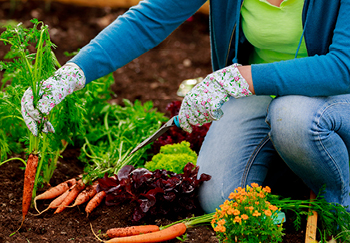
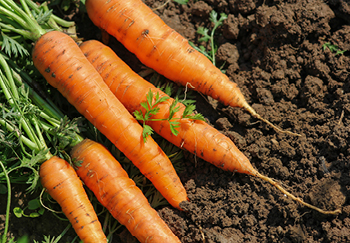
Why Grow Carrots at Home?
Carrots are one of the most popular and versatile vegetables around. They are rich in antioxidants and are packed with fibre, vitamins, and minerals too. There are many studies about the health benefits of carrots, from helping our immune systems, bones, and more. There are even studies that show carrots may help to prevent several types of cancers – wow. Interestingly, carrots are one of the very few vegetables that are more nutritious when cooked.
Another reason, store-bought carrots do not compare. The carrots available in supermarkets may be cheap, but they’ll never be able to match the freshness, or the flavour, or even the wonderful crunch of homegrown carrots, right from your very garden. Store-bought carrots are grown for their longevity at the cost of other things like flavour, size and texture. With homegrown carrots you can achieve better quality vegetables that will last as long as you need them, that are also better for you. Compelling, right?
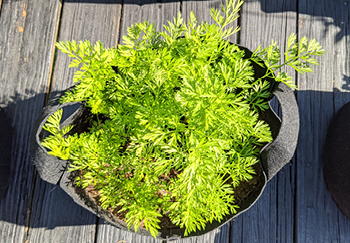
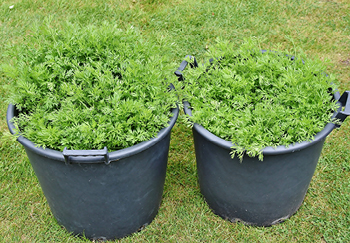
What Variety of Carrots Should You Grow?
There are quite a few varieties of carrots to grow. More than you might think. Carrots come in an array of sizes and even colours. Thankfully, they are all super easy to grow for a gardener of any experience, and they’ll generally keep for several months no matter the variety. The specific variety you will want will depend on the use case. Think to yourself what you want carrots for, whether it be soups, salads, general cooking, all-rounders that are good for everything, colourful beyond just orange, big, small. Consider all that and you’ll narrow in on the best types for you in no time.
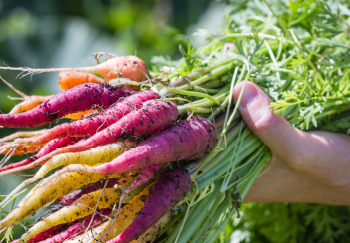
Short vs Long-Rooted & Earlies vs Maincrop Carrots
Carrots are generally classified as short- or long-rooted, and early or maincrop type. Don’t panic at these terms, it’s all very simple, and necessary to consider when it comes to purchasing the carrots you want. You would want to purchase seeds thinking it’s the long-rooted variety only to find short stumpy carrots when it comes to harvest. Basically, short-rooted carrots are shorter and sometimes stumpier looking than their long-rooted counterparts. Long-rooted carrots are more akin to the ‘classic’ carrot we are accustomed to.
Carrots are also classified as being either early or maincrop. Early varieties of carrot are generally sown in spring making them ready to harvest in about 8-10 weeks, usually from early summer to midsummer. Early carrots are generally smaller in size and typically eaten soon after harvesting. This is in comparison to maincrop varieties of carrot which are generally sown towards the middle to end of spring, taking about 14-16 weeks to come to harvest. Because maincrop varieties are in the ground longer they are generally larger and produce a larger harvest. Maincrops are typically harvested in late summer or early autumn. Whatever variety of carrot you wish to grow just be sure of their specific type, when to sow, when to harvest, and any individual needs or characteristics they may have.
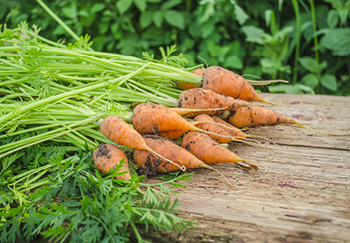
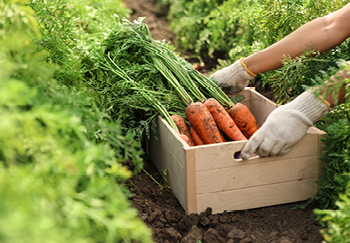
Varieties to Try
If you’re a beginner, up until now you probably thought a carrot was either ‘normal’ or a ‘baby’ and they were all orange. But you’d be forgiven as our UK supermarkets aren’t exactly known for the full array of wonderful veg on offer that our country can grow. You get one or two choices and that’s it. But with all vegetables, there are so many more varieties, and therefore choices, out there that you can only really experience if grown by yourself, from a local farm shop, or at a local fete or similar. This list below is just a small selection of the many varieties of carrot you can choose:
Amsterdam Forcing (short & early)
This is a very popular, short-rooted, early variety of carrot with blunt ended roots. It is suitable for container growing or when space is restricted. The carrots develop a good orange colour quickly and have a great, sweet flavour. They are quite good for storing and even freezing.
Early Nantes 2 (short & early)
Originating from Nantes, this is an early variety of carrot, short-rooted, good for container growing or when space is tight. These carrots develop a deep orange colour with a good crunch, and sweet flavour. Also good for storing and freezing.
Maestro (long & maincrop)
This variety is known for its pest and disease resistance. It is also relatively fast growing and produces good quality, bright orange carrots.
Flyaway (long & maincrop)
These are British bred carrots that are known for resistance to pests. They are deliciously crunchy with a sweet flavour and smooth orange skin..
Autumn King (long & maincrop)
The Autumn King is a particular favourite of gardeners because it is large and long-rooted growing to roughly 25-30cm long. It is very hardy and will stores well over winter. It has slight resistance to carrot fly.
St Valery (long & maincrop)
Originating in France, these are a great choice if you want a plentiful crop with lots of huge carrots, and, not at the expense of flavour we might add.
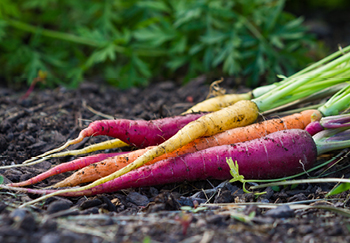
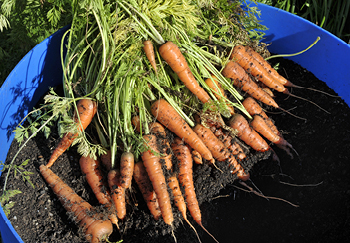
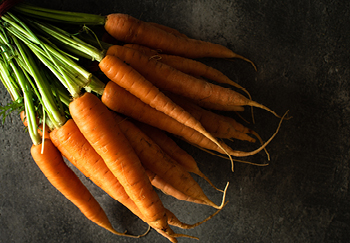


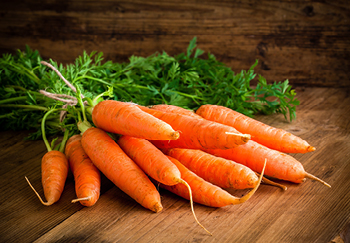
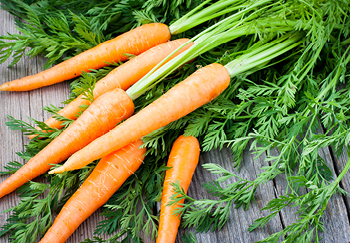
You Can’t Grow Carrots from Carrot Tops
Unlike some other vegetables that can be grown by replanting them (though we do not typically advise it) carrots cannot be grown from planting carrot tops. What will grow though are the carrot tops themselves. It is incredibly easy to do, and a good one for kids because they grow so fast. It will produce a little ornamental plant with fern-like foliage perfect for the windowsill.
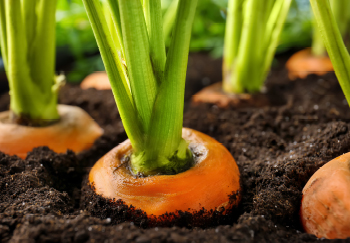
General Growing/Harvesting Timescale for Carrots
As we covered earlier, when it comes to planting your carrots, there are Early and Maincrop varieties. Early varieties are harvested sooner when compared to maincrop carrot varieties.
Based on a rough start date sometime mid to late March/early April:
- Early carrots roughly 8-10 weeks days after planting to mature and should be ready to start harvesting in mid to late June.
- Maincrops take the longer to mature, at roughly 14-16 weeks or around mid to late August.
Please note, this is just a rough guide and you should research individual growing and harvesting timelines for your chosen varieties of carrot. Weather and growing conditions will also be factors to consider. If you are in a colder region of the UK on average, it might pay to wait a bit longer to plant. You could sow your seeds all the way up until July with minimal issue.
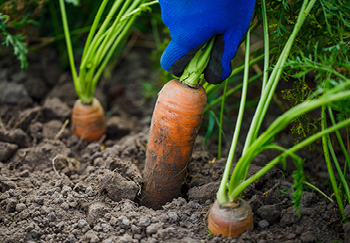
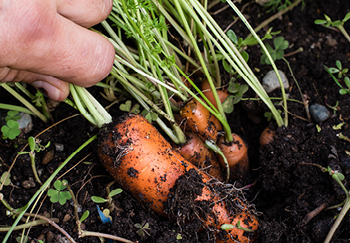
How to Start Growing Carrots
Now you know more about carrots you’re ready to get started preparing to grow your own at home. It pays to know what to do in advance so please read through our guide, get up to speed, and then when you’re ready to go, get started! Remember, you’ll be starting off from carrot seeds and will need to consider and prepare your ground ahead of time.
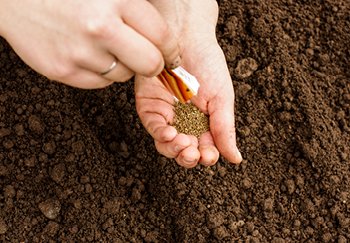
Preparing the Ground & Soil
Preparing the ground and soil for your carrot seeds is essential work, and is often the difference between a successful, plentiful crop, and a poor one. Carrots require an open, sunny spot, and fertile, well-draining soil. They also don’t particularly like stony or clay soils, so these will have to be dug out or the soil replaced in advance. Next, start preparing your chosen site in late winter or early spring. To help decide on the size of space you need to measure out and then prepare, you will be planting the seeds in shallow drills about an inch deep. Each carrot seed will be planted about 5cm apart and each drill will have to be about 15cm apart too. A ‘drill’ or ‘seed drill‘, is simply a channel or groove made within the soil, like an indent, for sowing seeds in, usually done in straight rows.
So, now you have calculated your rows and measured out your growing area, it’s time to prepare the soil. Dig it thoroughly and deeply with a fork, to break up any lumps of soil, and remove as many stones you find as you can. Remove all weeds you come across too. At this stage it would be worth adding some compost or well-rotted manure, but take note, do not do this if you are late in preparing your site. Carrots don’t like a lot of fresh compost or manure, so make sure to do it all in advance and give it some time to settle in before sowing your seeds.
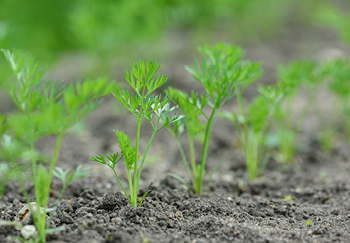
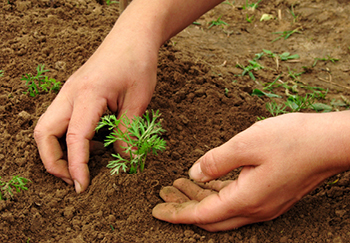
Sowing the Seeds
Just before sowing, water the prepared area. Next, create your drills about 2cm – 3cm deep (roughly an inch) and space them 15cm apart from one another. Next, sow your seeds within the drills roughly 5cm – 7cm apart from one another, avoiding overcrowding. Create your drills easily in the soil with the point of a trowel or hand fork. Sow a few more seeds than you think you’ll need to account for any losses or weaker plants in the weeks ahead. Finish off by covering the seeds with a thin layer of soil and water in well.

Growing
Carrots don’t require that much care. Over the coming weeks continue to keep the area clear of weeds and water regularly but minimally, a little bit more in drier periods. Carrots are drought resistant so too much water can cause them to split which can ruin the flavour and make them nigh on unpeelable too. Over time, the carrots may show a little above the soil. If this happens simple earth them up again with soil to stop them turning green. Some other guides advice thinning out your seedlings but so long as they are spaced adequately already, this is a pointless task. It can also attract more pests such as Carrot Root Fly that smells the crushed foliage when they are pulled up.
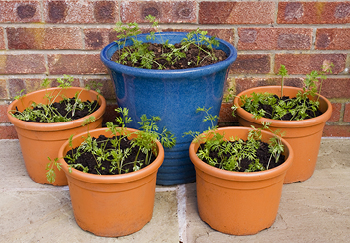
Harvesting
As mentioned earlier, when to harvest will depend on your chosen carrot variety, weather and growing conditions. But when the exciting time comes to harvest, water the soil first because the most ground will make it easier to pull them up. Once moist enough, start pulling them up! If you are unsure if they are ready, you can pull one or two as a test before pulling the rest. Don’t let them grow too big though, as this can diminish their flavour.

Storing Them
Carrots generally store well and will last up to four months. Choose only the best carrots cleaning them of any remaining soil and cutting their leaves. Disregard any that show early signs of rot or other imperfections. When you’ve chosen your carrots put them in layers in a bucket or box filled with damp sand, then place the bucket/box somewhere cool and dark. Carrots can also be stored in the fridge but for a shorter period. Clean and remove the tops of any carrots you wish to store and place them in the fridge. They should last for three to four weeks. Some carrots will be fine frozen so prepare them in the same way as above if storing in the fridge then place them in your freezer. If you want to freeze them do this as soon as you can to preserve their nutrients and flavour. Thaw thoroughly before use..
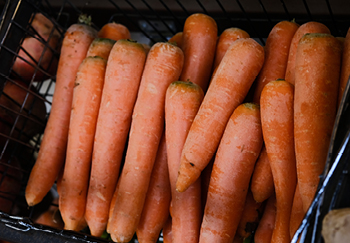
Watch Out for the Carrot Fly
Carrots are generally a pretty hardy and easy plant to grow if you do it right. However, they have a pest that really loves them. The Carrot Fly. This pest is drawn to the carrots by the smell of crushed foliage when thinning the plants out during growing. But remember what we said earlier? Space your carrots out enough and you won’t need to thin them out, thereby greatly reducing the risk of attracting these flies.
Another way to ensure carrot fly stay well clear is to use a barrier. Placing a shield of thin mesh or clear polyethene at least three to four feet high will prevent them easy access, as they are typically a low-flying insect. Additionally, there are some fly resistant varieties you can grow too. Prevention is better than cure with these pests, so if you have them it’s likely your crop is going to be ruined.


Your Very Own Home-Grown Carrots
And we’re done! You’ll be more than satisfied by the sweet, fresh and crunchy goodness of carrots you’ve grown by yourself. Reading through this guide has hopefully shown you just how easy it is, we hope you’ll give it a go. And if you happen to make a good carrot cake with your homegrown carrots, send a slice or two our way.

Useful Links
- Shop Online for Carrot Seeds
- Top 5 Fast Growing Vegetables (Video)
- Growing Carrots in Containers from Seed to Harvest (Article)
- Growing Onions from Seed to Harvest (Article)
- Growing Potatoes from Planting to Harvest (Article)
- Growing Chillies from Seed to Harvest (Article)
- Guide to Growing Tomatoes in Pots (Article)
- Grow Your Own Herbs (Article)
- Grow Your Own Strawberries (Article)






